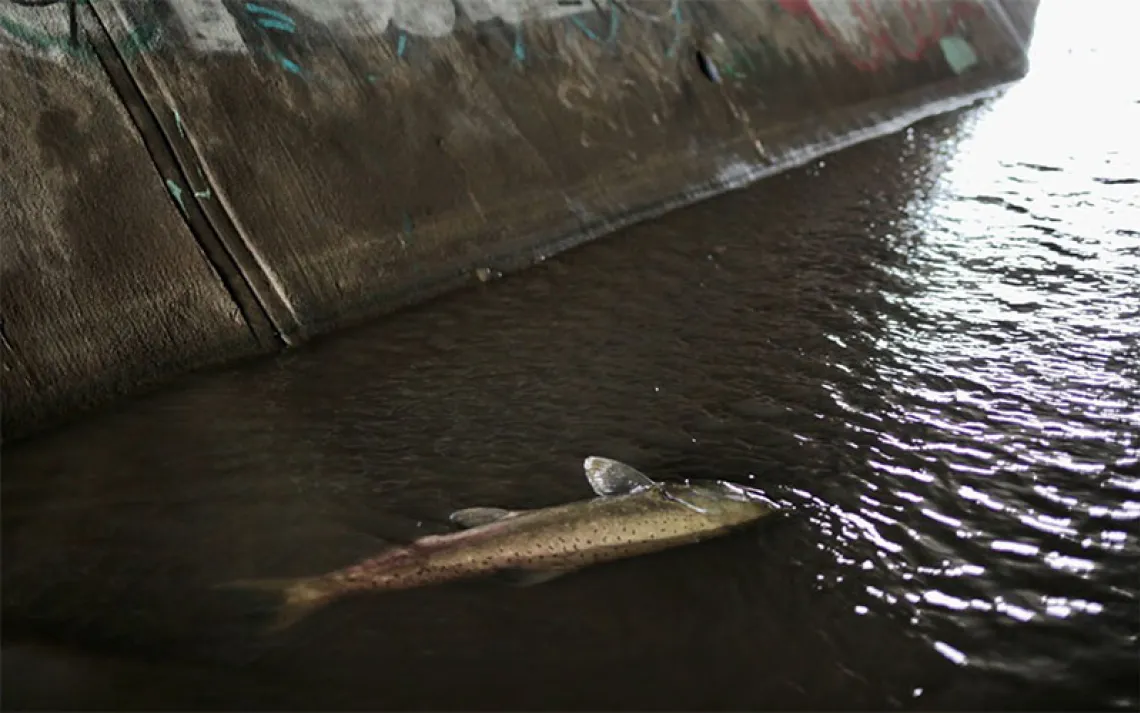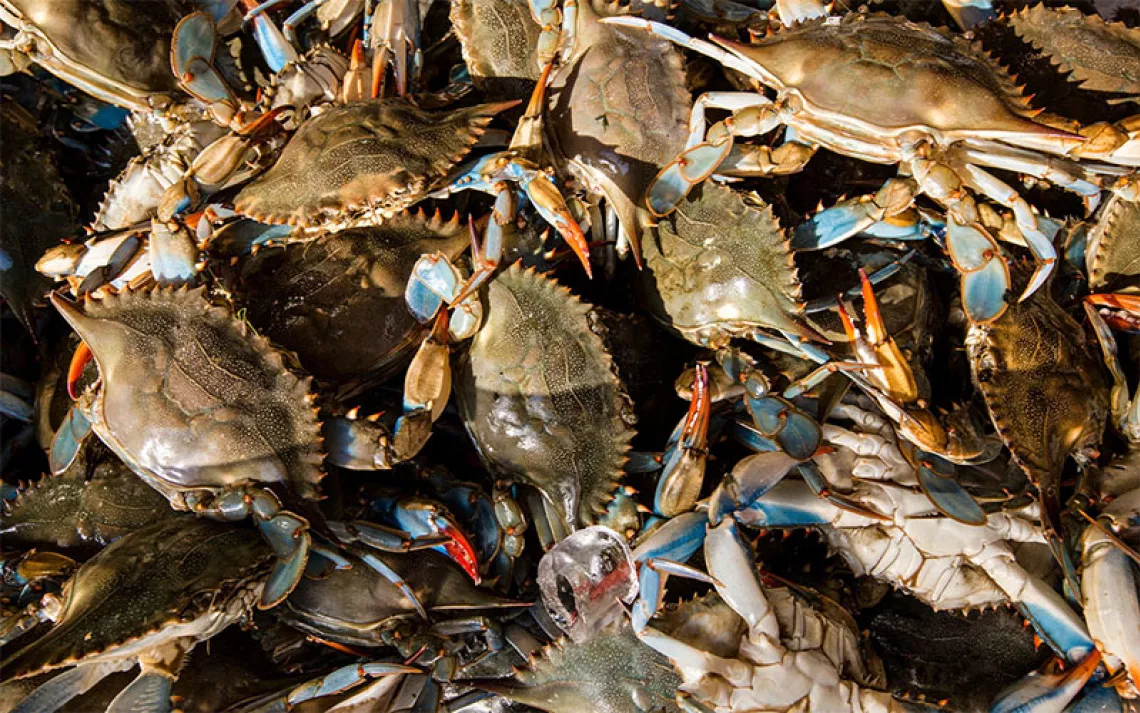Bats May Be Poised for a Comeback From White-Nose Syndrome
This could be good news for all wildlife ravaged by fungal diseases

Bat with white-nose syndrome in Great Smoky Mountains National Park | Courtesy of U.S. Fish and Wildlife Service
Ever since white-nose syndrome (WNS) began ravaging certain species of hibernating bats in northeastern North America in 2006, there’s been a long stream of bad news and devastating prognoses for the insect-devouring predators. WNS is a cold-loving fungus originating in Eurasia, where bats evolved to develop immunity to it. In the United States, where it arrived only recently, WNS disrupts bats’ winter sleep, causing them to expend too much energy as the snow-hued fungus grows over their noses and wings. To date, an estimated 6-plus million bats have succumbed to the disease—caused by a fungus called Pseudogymnoascus destructans (Pd)—as it’s moved across the United States and Canada, so far infecting 15 species in North America.
Some species are experiencing near total collapse: Little brown bat populations have been decimated by about 90 percent, while tricolored and northern long-eared bats are suffering losses of around 97 percent. Ecologists thought WNS might halt at the Rockies, but in 2016 news broke that it had made its way to Washington State. One of the most precipitous declines in wild mammals conceivably had no end.
A slew of new research into hibernating bats and the disease, however, offers some glimmers of hope. It’s the product of a national plan developed by the U.S. Fish and Wildlife Service (USFWS) beginning 10 years ago, which pulled together biologists, ecologists, mycologists, biochemists, and other scientists working in universities, NGOs, and state, federal, and tribal agencies to identify, and hopefully eradicate, Pd.

Little brown bat with WNS symptoms | Courtesy of University of Illinois/Steve Taylor
“A lot of early work was just fast response on detection and how to keep up with the disease,” says Daniel Lindner, a mycologist with the U.S. Forest Service. “But lately we’ve been able to turn a corner and focus more on causes and how to break that cycle.”
A huge leap was made using genomics; sequencing Pd’s genes allowed Lindner and fellow researchers to first determine the fungus’ origins. This past January, Lindner coauthored another genomic study showing that Pd, unlike similar fungi, was missing an enzyme that lets it repair its own DNA after exposure to UV light. This was a welcome sign of possible weakness.
“We’re hoping we can find a dose that damages the cells of the fungus without damaging the cells of the bats—or injuring their eyes,” Lindner says.
UV light’s potential as a treatment is currently being tested by mammalogist DeeAnn Reeder and her immunologist colleague Kenneth Field at Bucknell University in Pennsylvania. Sixty WNS-infected little brown bats collected in Wisconsin are presently hibernating in Reeder’s cold but humid manmade hibernacula chambers, which look like glass-fronted refrigerators and mimic the bats’ natural overwintering, or hibernation, spaces. Inside one of them, a test group of bats is being exposed to doses of UV light. “We think there’s real potential here,” Field says—if not for treating the bats themselves (it would be a logistical nightmare to find them all in the wild) then for treating the caves and mines in which they hibernate.

A bat at the entrace of Mt. Aelous Cave in Vermont | Courtesy of Ann Froschauer/USFWS
In the last two years, Reeder and Field have been involved in other heartening WNS research. The primary way WNS kills bats is by causing them to wake too frequently from hibernation, using up stores of fat and energy. One of Reeder and Field’s papers, from 2017, shows that some less-devastated species, like big brown bats, either have natural resistance to Pd or have figured out how to evade it. Another piece of good news, according to Field, is that remnant populations of infected little brown bats are now managing to reproduce. “That’s helping them recover,” he says, “and pass on good [resistant] genes to their offspring—what we call evolutionary rescue.” Will similar outcomes emerge in other populations? “We’re hoping that if we can keep some of these species from completely bottoming out for long enough, evolution and resistance will kick in,” Lindner says.
Paul Cryan, a research biologist with the United States Geological Survey (USGS), has also found evidence of possible adaptations. He and a team installed thermal cameras in two caves in Virginia and Indiana to watch infected little brown and Indiana bats hibernating over three winters. In analyzing the footage, he discovered that the Indiana bats had developed a WNS coping strategy of waking up together every night. He speculates that the extra group warmth limits either the spread of the cold-loving fungus, or the energy-usage of the bats, allowing them to survive until spring.
Conversely, the little brown bats “do not have the ability to coordinate their winter warm-ups,” Cryan says. Instead, they seem to have figured out how to limit the number of times they wake up; it’s a survival strategy that’s working for this studied group so far. Cryan points out that such encouraging results will help wildlife managers prioritize interventions for species that are most at risk.
Jeremy Coleman measures positive outcomes a little differently. He oversees USFWS’s National White-Nose Syndrome Plan, working to coordinate efforts among more than 100 research and consulting partners, distribute funding, and convince Congress of the essentialness to ecosystems of preserving bats. While he’s heartened that gray, big brown, and eastern small-foot bats are faring better than they were a decade ago, and that little browns are “persisting” in some regions, he notes,“You can’t dismiss the fact that bats are still dying, the disease is still spreading, and several species are potentially facing extinction.”
But, he says, the multidisciplinary efforts spearheaded by USFWS represent the kinds of strategy needed for future responses to such epidemics. WNS and other fungal pathogens—diseases— that harm wildlife are on the rise, due to increased human visits to previously remote places, which ups the risk that people will track pathogens out with them; and also climate change, which can create wetter conditions that allow some fungi to thrive. Amphibian chytrid fungus, for instance, has helped lead to declines or extinctions of an estimated 200 species of frogs around the globe in the last 30 years. And snake fungal disease is spreading across the eastern and midwestern United States.
“How do we build an international disease program, how do we fund it, how do we reach out to people to bring innovation, and what tools can we use to control and manage these diseases?” Coleman asks. The lessons learned from coordinated WNS efforts will hopefully “reveal some basic science that will help us understand how to respond,” and maybe save bats—and other species, too—in years to come.
 The Magazine of The Sierra Club
The Magazine of The Sierra Club



